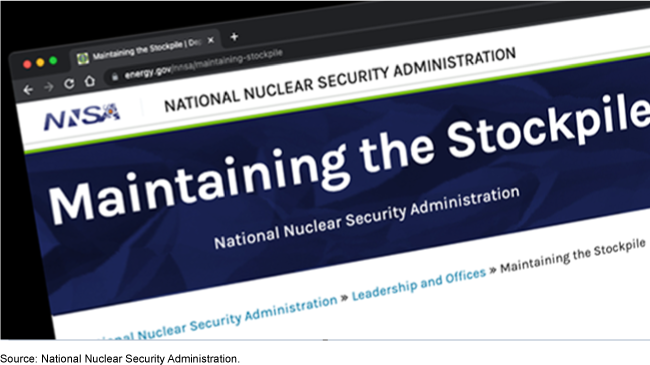Nuclear Weapons: Technical Exceptions and Limitations Do Not Constrain DOD's Planning and Operations
Fast Facts
As it modernizes the U.S. nuclear stockpile, the National Nuclear Security Administration is working to ensure its continued safety and reliability.
NNSA assesses the weapons prior to releasing them to the military services to ensure that they meet DOD's requirements for safety and performance. NNSA documents any exceptions and limitations that may be found as the weapons age and their parts need to be replaced.
None of the 90 exceptions and limitations that NNSA identified hinder DOD's ability to store, maintain, or operate the weapons.
DOD has developed strategies to mitigate any discovered risks, where necessary.

Highlights
What GAO Found
The National Nuclear Security Administration (NNSA) currently identifies 90 technical nuclear weapons exceptions and limitations in six categories (see fig.). In partnership with its nuclear weapons design laboratories, NNSA maintains, enhances, and reports on the safety and reliability of nuclear weapons. NNSA issues major assembly releases (MAR) to the Department of Defense (DOD) when nuclear weapons are released to the military services. MARs describe, among other things, exceptions to weapons' ability to meet DOD's requirements and limitations to their deployment or handling. NNSA and DOD officials said that none of the exceptions and limitations rise to a level that would require a weapon to be removed from the stockpile.
Figure: Number of Nuclear Weapons Exceptions and Limitations by Category

NNSA officials told GAO that ongoing and planned modernization programs are expected to address as many nuclear weapon exceptions and limitations as feasible. Laboratory representatives said that they work with NNSA and DOD to weigh the risks posed by exceptions and limitations against the design costs associated with addressing exceptions and limitations through modernization.
According to DOD officials, current nuclear weapons exceptions and limitations do not constrain their ability to store, maintain, or operate nuclear weapons. In some cases, DOD has accepted exceptions or limitations because they concern scenarios with a low probability of occurrence. In other cases, DOD has developed mitigation strategies to reduce risk, including maintenance safety protocols, secure storage and transport, and joint testing. According to DOD officials, the current and projected stockpile size and composition enables DOD to develop flexible operational plans. However, future flexibility may decline because of stockpile aging.
Why GAO Did This Study
Most nuclear weapon types currently in the stockpile were designed and produced over 30 years ago. To extend weapon and component design lives, the United States is in the midst of the most extensive nuclear weapons stockpile modernization effort since the Cold War era. Maintaining and enhancing the safety, security, reliability, and performance of the U.S. nuclear stockpile is part of NNSA's mission. Through its surveillance program, NNSA continually assesses each nuclear weapon to determine the safety and reliability of the stockpile. NNSA and its laboratories prepare reports for each weapon type, indicating that it is satisfactory for release to the military services, and describes, among other things, the weapon's exceptions and limitations.
Senate Committee Report 117-39 includes a provision for GAO to update existing work on nuclear weapons limitations. The objectives of this review included describing (1) the current types of nuclear weapons exceptions and limitations; (2) the extent to which they are planned to be addressed through modernization programs; and (3) the extent to which exceptions and limitations constrain DOD's ability to store, maintain, or operate weapons.
GAO reviewed NNSA and DOD documentation describing exceptions and limitations and how they are planned to be addressed through modernization and mitigation. GAO also interviewed knowledgeable DOD and NNSA officials.
For more information, contact Allison Bawden at (202) 512-3841 or bawdena@gao.gov.
